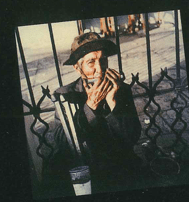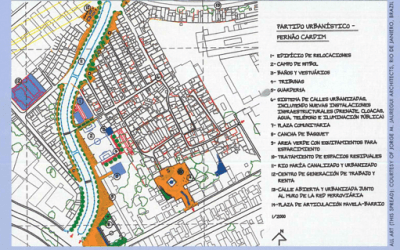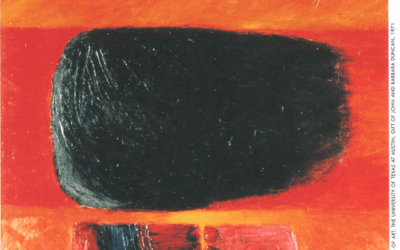The Twilight of the Pontiffs of Art Criticism
…and the Rise of Art History
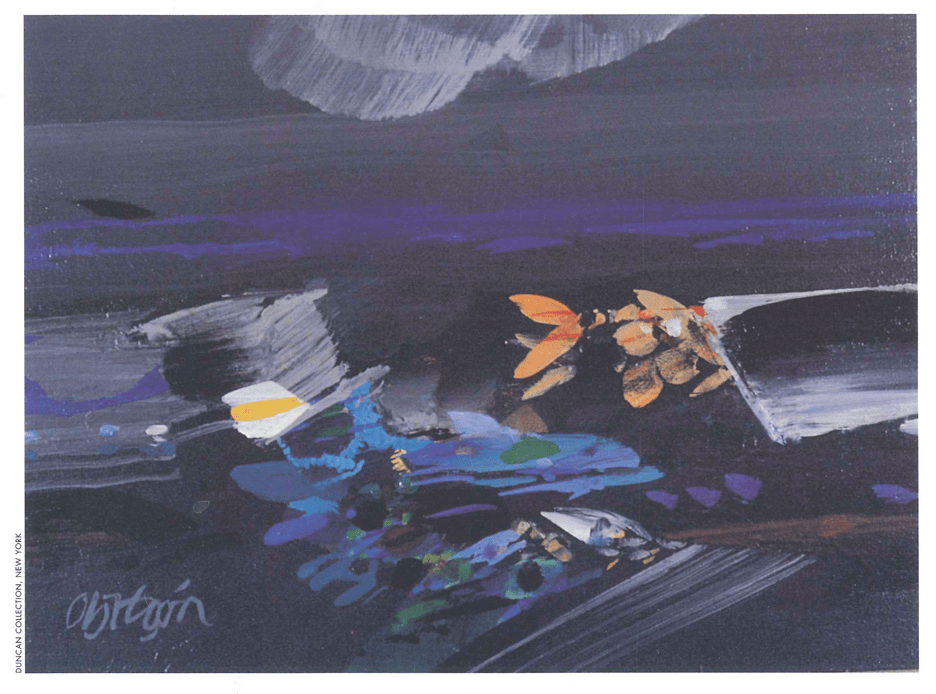
Alejandro Obregón, Untitled.
Latin American bookstores-just like their counterparts in the United States and elsewhere-always promote their favorite and bestselling books by keeping them in the public eye. Indeed, the displays in bookstore windows and on prominent merchandise tables often determine the profile of the seller.
Today, in Mexico City and Buenos Aires, bookstores often showcase works about art and art history. A decade ago, these books gathered dust on hard-to-find shelves. The same shops now feature recent works on contemporary artists, panoramic studies that propose a master map for artistic production with recently discovered scope and variety, and catalog-books of exhibits that translate into a new level of visual expectations in Latin American societies. Browsing the bookshelves, one now readily finds the complete works of Alejo Carpentier with his essays on art and the two volumes of art-focused Los privilegios de la vista by Octavio Paz. In a culture where books that don’t sell well go out of print quickly, the browser can still find the second edition of Damián Bayón’s Pensar con los ojos. Ensayos de arte latinomericano (Thinking with Eyes; Essays on Latin American Art), a 1993 reprint of his 1982 collection of essays and interviews.
What one doesn’t find, however, are the works of Jorge Romero Brest and Marta Traba, art critics whose prolific activity contributed decisively to laying the groundwork for the hegemony of modern art in Latin America. In a hyberbolic way, the two functioned as agents of the maelstrom of cultural modernization. They were present day after day with a stream of art reviews, constantly putting forth aesthetic and epistemological criteria. They were always looking at ways of painting and reading specific works, with a practice of art history somewhere between irritation and exasperation set down in personal journals and art theory like bricolage. Thus, from the 50s until the 70s, they were the driving force behind mainstream Modernism, serving as a catalyst, even as directors of Museums of Modern Art, to articulate heritage and canon.
So what does it indicate that the writings of Brest and Traba are not found in Latin American bookstores? Is it perhaps an indication of the way the reorganization of cultural capital is experienced in the art field by the Spanish-speaking countries of the Americas. Now that these positions are no longer cutting-edge, today’s consumer demand, booksellers’ decisions, and the politics of publishing houses relegate their work to the back of the shop. Beyond the bookstores, audience expectations have also undergone a clear shift in their attitudes towards exhibition practices as well as in the ethos of aesthetic practices themselves.
The question is not only that of an act of positive codification of cultural memory. The positions and art narratives of Romero Brest and Traba might have put on the agenda a productive conversation in the context of contemporary debates. Therefore, the apparent lack of interest in their work is a great paradox. They are shuffled aside precisely at a time when art history has become the predominant focus for capturing and theorizing the heterogeneous multiplicity of artistic production within the many non- synchronicities in today’s Latin America. One might look for answers in the fact that art history discourse has begun to differentiate itself from that of art criticism in Latin America, precisely at the point when art criticism has been able to become an object of historical study. In this way, one can encounter the discursive logic and historical determination of certain arguments.
Read restrospectively, the essays of Carpentier, Luis Cardoza y Aragón, Octavio Paz and José Lezama Lima, as well as the texts of Gabriel García Márquez, and the extensive activity and ample publications of Marta Traba, make up part of the body of work from which two generations of writers created ways of talking and writing about art in Latin America. Political activists such as Mário Pedrosa and professional liberals such as Brest also contributed to this conversation. The lack of interest in this body of literature could derive from shifts in structures of feeling, perception and experience that condition the emerging parameters. The expansion of cultural industries has ended up to a large extent secularizing and internationalizing symbolic worlds. The market has taken over the networks and dynamics in the area of culture. But the important thing is that writers, as well as critics, have managed to establish a discourse, a surface of mediation. Michel Foucault talks about a similar discourse in the first volume of The History of Sexuality, “We must conceive discourse as a series of discontinuous segments whose tactical functions is neither uniform nor stable. To be more precise, we must not imagine a world of discourse divided between accepted discourse and excluded discourse, or between the dominant discourse and the dominated one; but a multiplicity of discoursive elements that can come into play in various strategies … because of its inherent multiplicity, no discourse is all encompassing nor finite, none ultimately ‘correct.'”
The archeology of the beginnings of this discourse on art and art criticism in Latin America gives us a surprising picture. Carpentier’s 1928 trip as a stowaway from Cuba to France forms part of the region’s literary legend. In 1926 Carpentier was recognized as the youngest editor in all of Latin America directing a most prestigious magazine. After spending several months in prison during the dictatorship of General Gerardo Machado on charges of participation in an alleged “communist conspiracy,” he boarded a transatlantic steamer, using the press credentials of his friend, surrealistic poet Robert Desnos, who had recently attended a conference in Havana. A lesser-known aspect of Carpentier’s history is that the beginnings of the discourse on art are marked by his groundbreaking and idiosyncratically imaginative avant-garde stories. They were written in crucial connection with a group of writers and ethnographers grouped around Georges Bataille in the magazineDocuments, which “delight(ed) in cultural impurities and disturbing syncretism,” as noted by James Clifford, author of The Predicament of Culture.
In Havana, during the twenties, Carpentier had tried to decipher and aesthetically evaluate santería ritual, sacred artifacts and religious altars, as well as the Afro-Cuban music that was springing up in the urban environment. The first real post-slavery generation was encountering the worlds of tourism and the record industry. In the Cuban music known as son, the same rhythmic combinations could be found as in Stravinski, reflecting an aesthetic of Cubism, as Carpentier thought. Writing about art from Paris and defying the blatant cultural conservatism of the Cuban elite in Social, the magazine read by members of the sugar and tobacco aristocracy, he raised the question of authority: how one adquires and maintains it and at what or whose cost. Carpentier took two separate tacks. On the one hand, he denied the specialized authority of the traditional critic of art. On the other hand, he placed his texts within yet a larger constellation, explaining the vibrant energy released by the multitude of para-aesthetic strategies of the avant-garde group.
Carpentier took advantage of this legitimation to advance agendas constructed from a field of potential alternatives with clear cultural political and territorial focus. He wanted to serve as a transatlantic bridge, to provide information processing about artists and artworks selected from the avantgarde scene, and to give the Latin American world a cultural and aesthetic sense of heterogeneous identities. In turn, this created the opening of spaces for recognition of the type of art practiced by Latin Americans. Ultimately, what counts is not the destruction of all traditional forms of representation in the name of the future, but the redefinition of the concepts of art and of artwork through the production Latin American art. Art entwined with life, to the mnemotic convulsions of its societies and cultures, as a symbolic guarantee of identity.
With the real conflicts and crisis of Latin American societies, the acceleration of history and the emergence of a new mediatic culture, these agendas of criticism were forced to change. But in spite of the ways that Latin American cultures could imagine their dark or brilliant future, two elements remained constant over a period of some 50 years. The discourse about art was practically exclusive to writers as lords of symbolic order. At the same time, their readings of specific works and artists, art tendencies, artistic practices or exhibitions did not want to be confused with art criticism, but sought to resolve problems of representation, narrative and aesthetics in their own fashion.
The powers of analogy formed the basis of the writers’ privilege to discuss art. To analogize is to put forth an illustration of a reality by means of a more familiar reality that is similar or parallel to it in some significant way. In 1983 García Márquez began an article about the painter Alejandro Obregón by telling a personal anecdote. One day a friend asked Obregón to help him look for the body of a boatowner who had drowned that afternoon. He and the man had been fishing in the man’s boat near Barranquilla when the accident took place. After saying that they spent all night looking in vain, García Márquez continues, “Suddenly Obregón saw him: he was submerged up to his crown, almost sitting in the water, and the only things floating on the surface were the errant strands of his hair. ‘He looked like a jelly-fish’, Obregón told me. He grasped the bundle of hair with two hands and with the colossal strength of a painter of bulls and storms drew the drowned man up, eyes open, huge, dripping with the slime of sea-anemones and manta rays, and flung him like a dead shad into the botton of the boat.”
Choosing narration and a figurative style makes them the medium for talking about the unrepresentable- the Real Thing itself- in other words. The highly condensed text uses a surprising turn of phrase unexpected by the reader. Nothing more nor less than Obregon’s analogic definition of art. “Obregón has recounted the episode to me over and over because I ask him to do so every time we get drunk together; his account gave me the idea for a story about drowned men. The episode is perhaps the instant in his life which most resembles his art. That is the way he paints -as if he were fishing drowned men up out of the darkness,” recounts García Márquez.
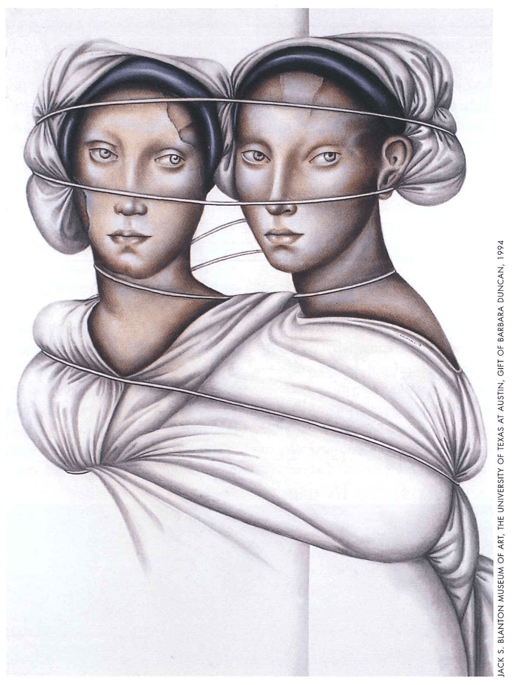
Carmen Aldunate, Two Figures, 1978.
Also unexpected is the resolution of the oppositions between the painting understood as window and the work of art understood as mirror, between art and life. According to García Márquez, in Obregón’s house in Cartegena, the entire sea comes in through one single window. In this house, one finds daily life and the “other life” painted everywhere. It is significant that the only painting mentioned by García Márquez is a free unicorn that Obregón drew one night on a wall that was later destroyed. The writer limits himself to evoke bulls, condors, barracudas, a wreath-crowned woman, that is, the heraldic representations that make up Obregón’s mythology, energized in an emblematic manner. In this way, he rejects criticism as an activity related to aesthetic pleasure, with the techniques to transmit that pleasure to others, to make plausible a scale of values, the appreciation of formal qualities. García Márquez’ narrative essay is more a poetic attempt to return those elements that would escape in Obregón’s art to the usual parameters of art criticism.
With visual culture emerging as a subject, the minimum common denominator of the renewed cross disciplinary history of art in Latin America is the premise that the visual experience, “visual literacy” is “not fully explicable in the model of textuality,” to use a phrase of leading visual representation theorist W.J.T. Mitchell. Thus, the range of research activities has expanded at institutions such as the Institute of Aesthetic Investigations at the Autonomous University (UNAM) of Mexico and the Julio Payró Institute at the University of Buenos Aires. The success of museums as a mass medium and new exhibitions practices added new demands to those of preservation. Now an exhibition can only be justified if it raises provocative questions that can be illustrated through a particular configuration of objects. Cultural life provides a pressure that has stimulated new themes and ways of looking at things.
At the same time, there has been a revision of tools of language and interpretative methodology implemented by art historians who have worked on Latin America and developed crucial research to situate Latin American visual production within the context of art in the rest of the world. In this way, the question “what is an image” has led to the theoretical understanding of the Ixitla in Pre-cortez México, completely differs from the phenomena which is understood in the West as “image.” The strengthened interest in objects in and of themselves is coupled with an intercultural perspective to examine crosscultural exchanges and western conventions of representation and their colonial significance. The accent has been placed on the multivalent signifying power of early hybrid images. Also, parallel with postmodern enthusiasm for the sublime, the aesthetic category of the marvelous “lo maravilloso” has been put forth. The notion of fetichism, part of an iconoclastic rhetoric that operated “as a metalanguage for the magical thinking of others” (Jean Baudrillard), has undergone self-subversion. And if appropriation was the favorite buzzword of the artistic elite in the 80s in the United States, understood along the lines of Duchamps-Warhol, the most pertinent terms of cannibalism and translation (“antropofagia” and “traducción”) are those now explored in Latin America to establish the theoretical foundations and workings of these operations.
In an article entitled ” Marta Traba’s Criticism Shook Up the Circles of Power,” an ERET Agency journalist described in 1969 the effect of her short stay in a Latin American capital: “It created a real commotion in the intellectual world that shook it at its very foundations….she didn’t hold back in the least bit from criticizing the ‘hotshots’ of the arts or letters and against the ‘parricides’ who in their haste to scale the ladder of fame don’t care about anything except getting rid of those above them.” Today the question is not one of obsolete standards nor of narcissistic defense strategies. The fears and anxieties that arise in the work of the new art historians have other social and cultural relevance. Among the major artistic events of the last few years in Latin America was the exhibition organized in Lima to document the iconological processes associated with the cult of Santa Rosa de Lima. In these images, mysticism and politics are intermingled. Scandal arose when one picture of the saint selected by the historian organizing the exhibition was ordered down and thrown out by church authorities. The portrait in question was a recent one that showed another small feminine figure in the background-the emigrant “saint” Sarita Colonia, who today is also the object of a widely pread popular religious cult. It’s not necessary to say that, having been expelled from the museum, this image of Rosa de Lima with Sarita Colonia is easily found on the Internet.
Winter/Spring 2001
Carlos Rincón, vice-director of the Latin American Institute of the Free University of Berlin, was the DRCLAS Santo Domingo Visiting Scholar in Spring ’00. He is the author of La no simultaneidad de lo simultáneo: posmodernidad, globalización y culturas en América Latina and Mapas y pliegues: ensayos de cartografía cultural y de lectura del neobarroco, which won the Colombia National Essay Prize in 1997.
Related Articles
Guatemala Diary
In a deeply personal way, I feel like I am home again. Of all the places I have visited, Guatemala is the country I love and feel closest to. Certainly the most impressive aspect is the persevering Mayan people, who endured a 30-year civil war…
From Favela to Bairro
The Brazilian firm of Jorge Mario J¡uregui Architects is the first Latin American recipient of the Harvard Graduate School of Design’s Veronica Rudge Green Award in Urban Design. The award…
Exploring New Horizons in Latin American Contemporary Art
When I first traveled to Peru by boat with my family fifty years ago, the country seemed as far away from Argentina as Boston from Buenos Aires. My husband had been sent there by W.R…

